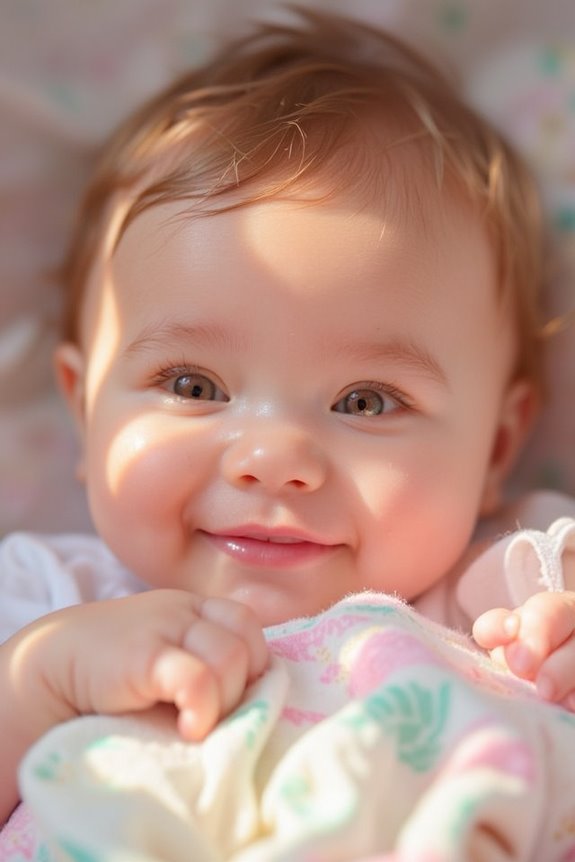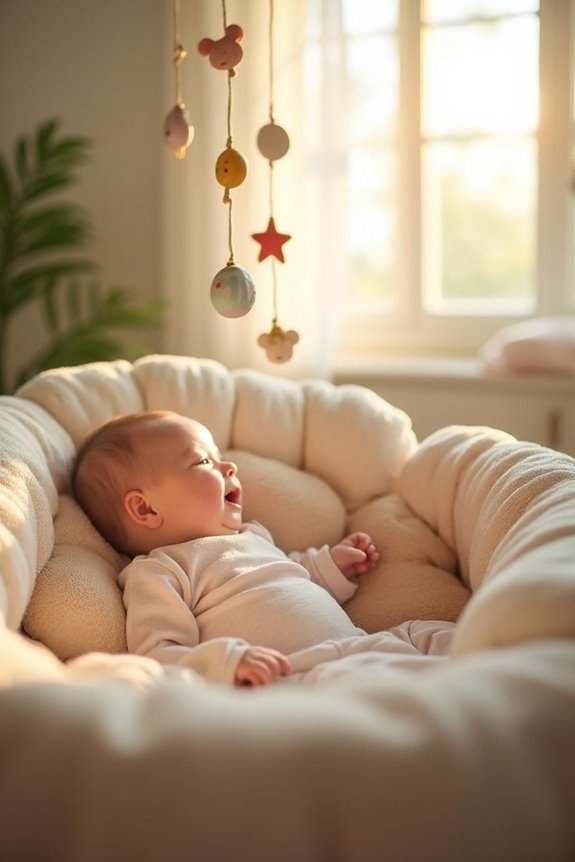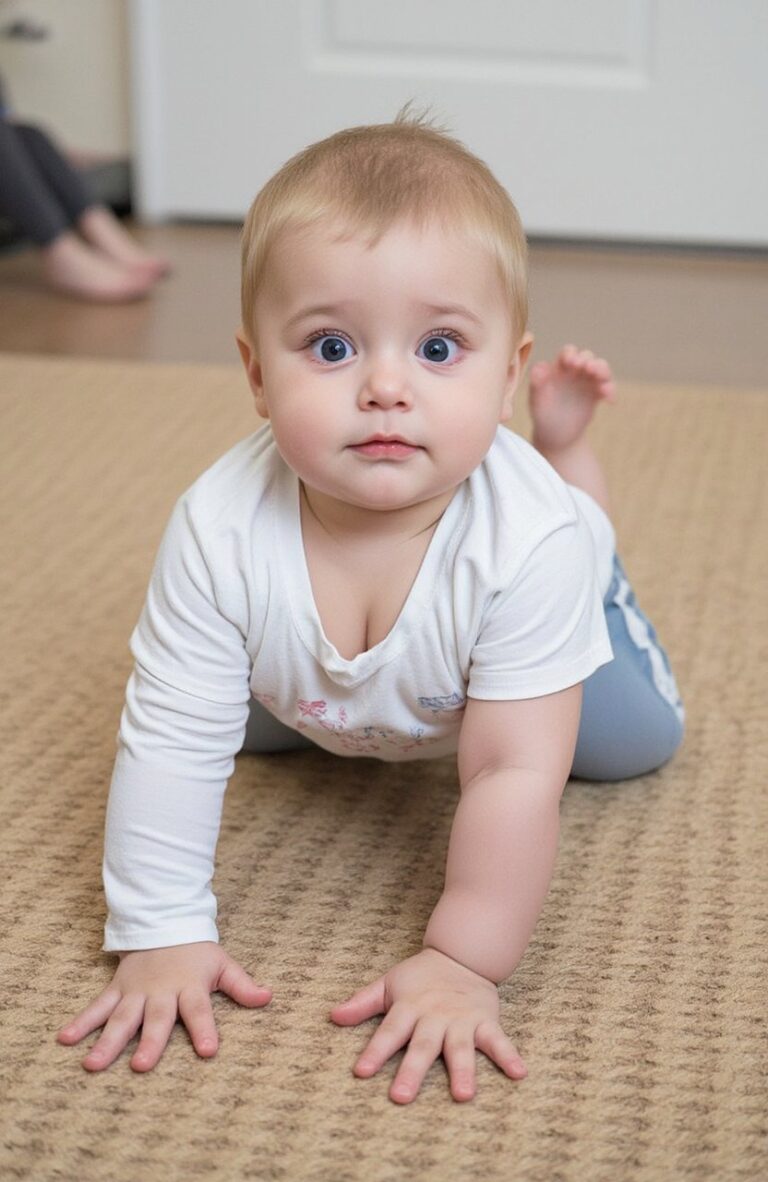Babies usually start smiling around six weeks old. Initially, they have reflex smiles, but by eight weeks, you may notice intentional smiles in response to your interactions. By three months, if social smiles aren’t happening, it’s a good idea to check in with a healthcare provider. Since every baby develops at their own pace, engaging them with play and routines can boost their smiles. Keep exploring to discover more about supporting your baby’s smiling journey.
Key Takeaways
- Babies typically start reflex smiles right after birth, with social smiles emerging around 6 to 12 weeks.
- Intentional smiles in response to interactions usually appear by 8 weeks.
- By 3 months, if social smiling hasn’t begun, consult a healthcare provider.
- By 4 months, babies often mimic facial expressions, enhancing social interaction.
- Variations in development mean some babies may smile earlier or later than expected.
Understanding Smiling in Infants
When do babies start smiling, and why is it important for their development? Typically, we see those delightful first smiles between 5 to 8 weeks, with reflex smiles appearing even earlier. As they grow, intentional social smiles emerge from about 6 to 12 weeks, marking a significant milestone in infant bonding.
- Creating Connections: Smiling fosters emotional expression, helping our little ones form secure attachments with us.
- Eye Contact: When they gaze into our eyes while smiling, it signifies genuine engagement and connection.
These early smiles are not just cute; they play a crucial role in developing social skills and emotional intelligence. By responding to their smiles, we reinforce positive emotions, nurturing a strong bond that’s essential for their overall growth.
The Journey From Reflex to Social Smiles

As babies grow, their smiles evolve from reflexive responses to intentional social interactions, marking a fascinating journey in their development. Initially, reflex smiles appear randomly, often during sleep, and don’t require any external stimuli. These fleeting smiles help strengthen the facial muscles needed for future social smiles.
Around 6 to 12 weeks of age, we’ll notice the shift to social smiles, which are brighter and more engaging. They respond to familiar voices and faces, showcasing our baby’s growing vision and hearing.
To encourage this transition, we can:
- Smile back at our baby.
- Engage in cuddles and playful interactions.
- Maintain consistent, positive connections.
These interactions foster a deeper emotional bond, supporting the delightful emergence of social smiles.
Timeline of Smiling Development
The timeline of smiling development in babies reveals key milestones that mark their social growth. Understanding these smile milestones helps us appreciate infant engagement as our little ones begin to connect with us.
- Newborn to 6 Weeks: Reflex smiles can appear right after birth, but genuine social smiles usually start around 6 weeks.
- 6 to 8 Weeks: By 8 weeks, you’ll notice more intentional smiles in response to your interactions.
- 3 Months: If social smiling hasn’t begun by this age, it’s a good idea to consult a healthcare provider.
- 4 Months: Babies often start to mimic facial expressions, enhancing their social engagement.
Factors Influencing When Babies Smile
Understanding the factors that influence when babies smile can help us better connect with our little ones during their early development.
Several key elements play a role:
- Vision Challenges: If a baby struggles with sight, it may delay their smiling.
- Caregiver Engagement: Regular interaction with us boosts their social smiles.
- Stress Impact: High stress levels can hinder their emotional growth.
- Cultural Differences: Our cultural backgrounds shape how and when we express smiles.
- Developmental Variations: Each baby develops at their own pace, influenced by their temperament and attachment styles.
The Significance of Reflex Smiles
Reflex smiles might seem like simple facial expressions, but they hold significant meaning in a baby’s early development. These involuntary smiles, often seen during sleep or while passing gas, are crucial for several reasons:
- Muscle Development: Reflex smiles strengthen facial muscles, paving the way for future social smiles.
- Neurological Growth: They signal early neurological development, preparing your baby’s nervous system for more complex interactions.
- Parental Bonding: When you respond to your baby’s reflex smiles, it fosters a connection, enhancing your bond.
While these smiles fade around two months, they serve as a foundation for genuine smiles that emerge later. Embracing these moments can create lasting connections, so let’s cherish them together as part of our baby’s growth journey.
Recognizing Social Smiles
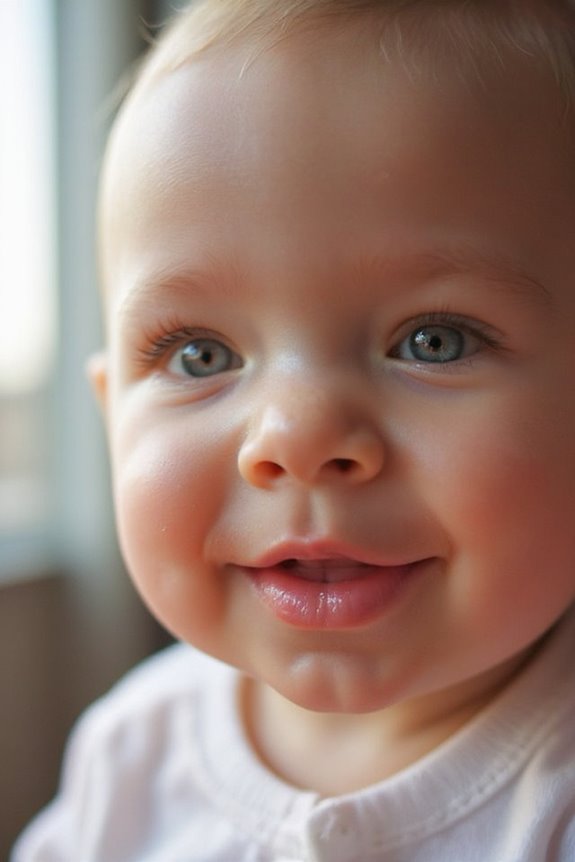
As we move beyond the fleeting moments of reflex smiles, it’s exciting to recognize the development of social smiles, which mark a significant milestone in our baby’s growth. Typically emerging between 6 to 12 weeks, these genuine smiles are longer and more engaging than reflexive ones. When recognizing genuine smiles, look for:
- Eye engagement and a mouth that turns up.
- Smiles often accompanied by wiggling or soft vocalizations.
- Responses to our voices, touches, or smiling faces.
These social smile characteristics reveal our baby’s increasing awareness of others and their environment. By interacting warmly, we encourage these smiles, fostering deeper connections and promoting healthy social development. Remember, if social smiles aren’t observed by 3 months, it’s worth discussing with a pediatrician.
Developmental Progression Beyond Smiling
While it may seem like smiling is the highlight of your baby’s early social development, there’s a whole world of growth happening beyond those delightful grins. As your little one progresses, we’ll notice remarkable cognitive milestones and emotional growth.
- Eye Contact: By three months, babies start making eye contact, deepening connections.
- Laughter: This joyful sound often emerges around 4-6 months, showcasing emotional relief.
- Understanding Cause and Effect: By ten months, they grasp how their actions lead to outcomes, enhancing their cognitive skills.
These developments, along with playful interactions like peekaboo, foster not just social skills, but also emotional maturity. So, let’s celebrate every stage of this journey together, knowing each smile is just the beginning!
Encouraging Smiling Through Interaction
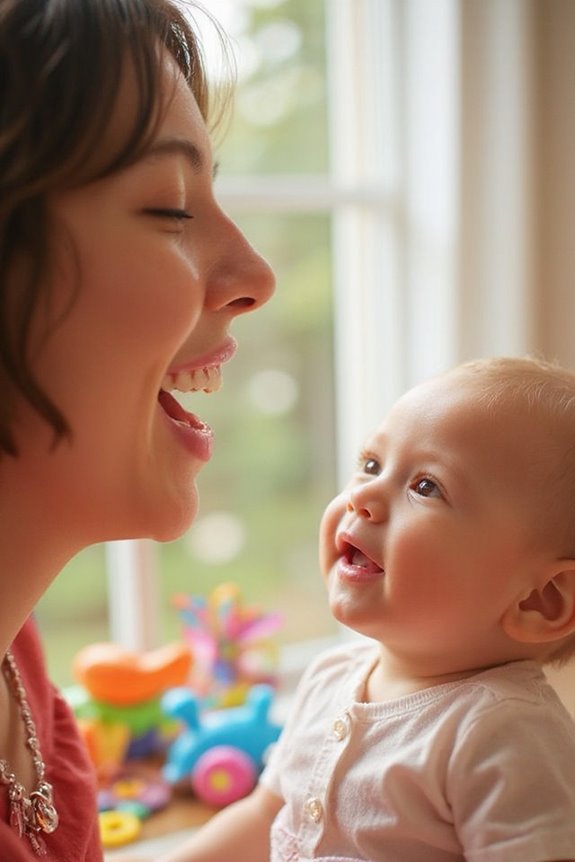
Encouraging our little ones to smile is not just about the joy of seeing their grins; it’s an essential part of their emotional and social development. By engaging in face-to-face interaction, we strengthen our bond and help them observe our expressions. Here are some effective strategies:
- Consistent Routines: Establish daily playtimes during which we can interact and smile together, like during mealtime or bath time.
- Modeling Behaviors: When we frequently smile and mirror their expressions, they learn through imitation.
- Environmental Stimuli: Introduce colorful toys or gentle movements to spark their curiosity and encourage smiles.
Monitoring Your Baby’s Development
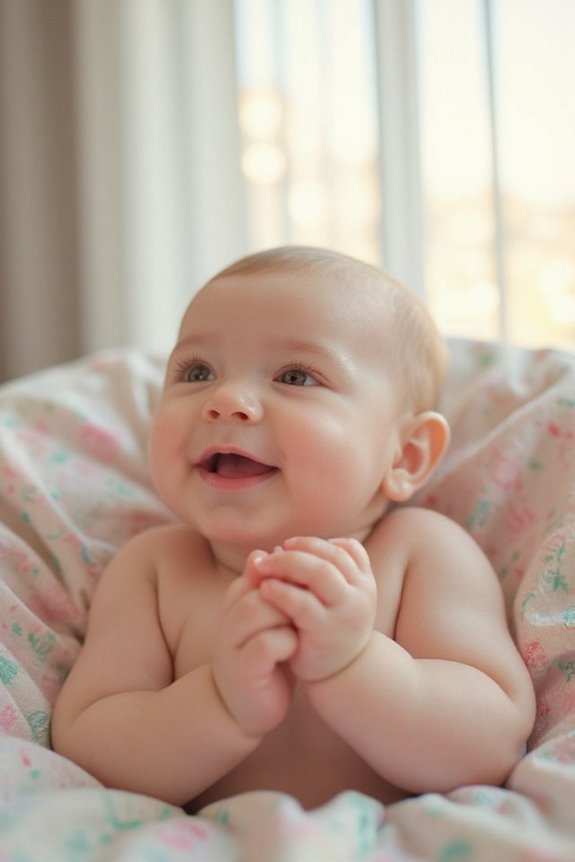
Monitoring your baby’s development is crucial, not just for tracking milestones but also for understanding their unique growth journey. As we observe their motor skills and emotional growth, we can celebrate each little achievement.
- Motor Skills: By two months, you’ll notice your baby can hold their head briefly. At three months, they start reaching for objects, and by six months, they’re rolling in both directions.
- Emotional Growth: At two months, they smile back at you, creating a joyful connection. By three months, eye contact becomes a delightful way to bond.
Keeping an eye on these developments helps us nurture our baby’s potential, ensuring they feel loved and supported every step of the way. Let’s cherish these moments together!
When to Seek Professional Advice

Recognizing when to seek professional advice about your baby’s development can be challenging, especially for first-time parents navigating the early months. If your little one isn’t showing intentional smiles by around 4 months, it’s wise to consider a pediatric consultation.
Here are some signs to watch for:
- Lack of Smiling: No social smiles by 3 months could indicate a need for evaluation.
- Engagement Issues: If your baby isn’t making eye contact or engaging with you, this warrants discussion.
- Behavior Changes: Any loss of previously acquired skills, like smiling, should be addressed.
Early intervention can make a difference, so trust your instincts and reach out for support when you have concerns. We’re all in this together!
Frequently Asked Questions
Do All Babies Smile at the Same Age?
Not all babies smile at the same age, and that’s perfectly normal. As we cherish our little ones’ smile development, let’s celebrate each baby milestone, knowing every journey is unique and filled with joy.
Can Premature Babies Smile Earlier or Later?
Like flowers blooming at different times, our premature babies may smile sooner or later than expected. Their emotional development is unique, and tracking those premature milestones helps us nurture their growth, ensuring every smile is cherished.
What if My Baby Never Smiles?
If our baby never smiles, it’s important to remember that every little one develops at their own pace. Emotional milestones vary, and we should engage them lovingly, seeking guidance if concerns linger.
Are Some Babies More Prone to Smiling Than Others?
Absolutely, some babies do seem more prone to smiling. Their individual temperament plays a big role, and we can enhance that with positive environmental influences, creating a warm, supportive space for those delightful smiles to flourish.
How Can I Tell if My Baby Is Smiling Socially?
We’ve all felt that warmth when our baby’s face lights up. If we notice them responding to our voices or smiles, those baby expressions indicate they’re starting to grasp social cues, creating beautiful connections.

